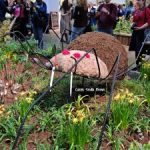Happy Valentines Day from my very chilly house in Philadelphia!
Each of us can create our own love letter to wildlife by learning to create welcoming habitat in our gardens to share our space with the birds, butterflies, pollinators, even frogs and toads and other creepy crawlies. Our wildlife gardens can become a garden full of life, a garden that supports local food webs, and a garden that is a delight to all of our senses because it is filled with these other beings who share our planet with us.
One of the best gifts you can give to wildlife in your garden is to reduce (even eliminate) the amount of lawn you have. So send your own love letter to your local wildlife by getting rid of your lawn now.
Wildlife Garden Pond attracts birds, frogs, toads, and dragonflies

How Lawns Harm Wildlife
Lawns are biological deserts and support very little wildlife.
Over 80% of our managed landscapes are made up of lawn. More than 80% of the remainder is planted with non-native ornamental plants. This leaves less than 4% for native plants in our landscapes. Let’s work on turning this “Planting Pyramid” on its head by decreasing the amount of lawn and increasing the amount of native plants. Doing both of these at the same time would create so much habitat for wildlife. We could make a huge difference for wildlife just by doing this.
Lawns use too much water
With over 46 million acres of lawn here in the US, this makes lawns the largest irrigated crop in this country. In the eastern US over 30% of fresh water usage is spent on irrigation. In the southwest it’s even worse: over 50% of available fresh water is used for irrigation. And for what purpose? To satisfy our strange desire to imitate an English estate? In many areas of this country “water wars” are already causing enormous strife because there’s simply not enough to satisfy the demand. Reducing your lawn would go a long way in solving the water crisis, and would help maintain existing wildlife habitat.

Lawns use too much energy
Mowing, blowing, weed-whacking, trimming, and all of the other activities that are required to maintain the perfect green lawn require huge inputs of energy, and we simply cannot afford to continue this waste. We hear all of this talk about reducing our reliance on foreign oil, and one of the best ways that we could do this would be to reduce our lawns, or eliminate them entirely.
We cannot afford to wait for our elected officials to solve this problem, they are obviously incapable of getting anything accomplished at all. Each of us must take responsibility for reducing the amount of energy we use in our landscapes and our other life activities. The production of energy is a direct cause of the loss of wildlife habitat. We are currently chopping off mountain tops, destroying our wetlands (Gulf Oil Spill), and destroying the arctic ice (essential polar bear habitat) in our quest for cheap oil.
Lawn chemicals kill wildlife
In the recent uproar over the fact that the National Wildlife Federation had partnered with Scotts Miracle Gro it became clear that most people were upset by this because the mission of the NWF is to protect wildlife habitat, while Scotts makes toxic chemicals that kill wildlife. An oxymoron at best, a completely misguided decision at worst.
You can have a healthy garden without the use of any toxic chemicals. When you reduce your lawn there is no need for “Weed ‘n Feed” herbicides, or pesticides. A healthy wildlife garden requires none of these toxic chemicals!

How to Reduce Your Lawn
It’s very easy to reduce your lawn by doing a little bit each year, say converting 10% of your lawn to wildlife habitat every year. And there are so many ways to do this without the need for toxic herbicides, which run off and pollute our streams and waterways.
Reducing your lawn and replacing it with native plants from your region will create more habitat for wildlife, and create a garden full of life. You’ll get to enjoy the sight of swirling butterflies, hovering dragonflies, nectaring native bees and so much more. And the air will be filled with the sound of birdsong. What could be better than that?
Ideas for Replacing Your Lawn
This post is part of an internet event to introduce a wonderful new book by Evelyn Hadden, Beautiful No-Mow Yards: 50 Amazing Lawn Alternatives, coming soon to a bookstore near you. This book is an exploration of the many ways to replace your lawn: rain gardens, ponds, meadows, shade gardens, edible gardens, and smarter lawns.
While the book does contain an extensive plant list, you will want to use locally native plants so that you are providing the best wildlife habitat for your region. Check with your local native plant society for help in choosing the best plants.
Beautiful No-Mow Yards is full of gorgeous photos to help you decide how to get rid of your lawn and create beautiful gardens and create welcoming habitat for wildlife. It’s kind of like a dream-book, full of inspiration and ideas. Just paging through the abundant photos will provide you with so many ideas for getting rid of your lawn.
When you do this you’ll be blessed with the gift of time — you’ll have so much more time to enjoy the beauty of your garden and the wildlife who will come to share it with you.
More From Ecosystem Gardening:
Submit your review | |








